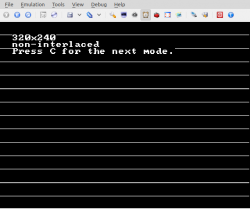slinga
Established Member
Starting a new thread to not hijack the other one,
Anyone have example source code to set 480p mode?
1) Charles MacDonald has a resolution demo here: Progressive hires test demo?. But it doesn't include source code.
2) MacDonald had an entry in the "C4 - 2006 Context" that is described as "A graphic demo in hires interlaced (or VGA output)". Unfortunately I don't even have the binary for that.
Barring source code I will attempt to RE the resolution demo.
Anyone have example source code to set 480p mode?
1) Charles MacDonald has a resolution demo here: Progressive hires test demo?. But it doesn't include source code.
2) MacDonald had an entry in the "C4 - 2006 Context" that is described as "A graphic demo in hires interlaced (or VGA output)". Unfortunately I don't even have the binary for that.
Barring source code I will attempt to RE the resolution demo.




